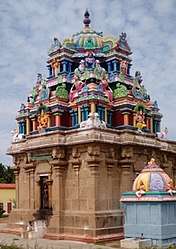Padikasu Nathar Temple
| Padikasu Nathar Temple | |
|---|---|
|
| |
| Geography | |
| Coordinates | 10°55′48.92″N 79°25′46.26″E / 10.9302556°N 79.4295167°ECoordinates: 10°55′48.92″N 79°25′46.26″E / 10.9302556°N 79.4295167°E |
| Country | India |
| State | Tamil Nadu |
| District | Thanjavur |
| Location | Alagaputhur |
| Culture | |
| Sanctum |
Padikasu Nathar (Shiva) Soundaranayagi (Parvathi) |
| Architecture | |
| Architecture | Dravidian architecture |
Padikasu Nathar Temple (also called SwarnaPureeswarar Temple) is a Hindu temple located at Azhagaputhur, a village in the Thanjavur district of Tamil Nadu, India. Shiva is worshiped as Padikasunathar, and is represented by the lingam. His consort Parvati is depicted as Soundaranayagi. The presiding deity is revered in the 7th century Tamil Saiva canonical work, the Tevaram, written by Tamil saint poets known as the nayanars and classified as Paadal Petra Sthalam.[1] The 8th century Saiva saint poet Sundarar has sung praise about the temple in his works.
There are various inscriptions associated with the temple indicating contributions from Cholas. The present masonry structure was built during the Chola dynasty in the 9th century, while later expansions are attributed to Thanjavur Nayaks during the 16th century.
The temple is built in Dravidian architecture with a three-storied gopuram, the gateway tower. The temple has numerous shrines, with those of Padikasunathar and Soundaranayagi being the most prominent. The temple complex houses many halls and two precincts. The temple has four daily rituals at various times from 6:30 a.m. to 8 p.m., and two yearly festivals on its calendar.
Legend

Praises of the temple have been sung in the Thevaram. Alagaputhur is the birthplace of Pugalthunai Nayanar, one of the 63 Nayanmars.[2]
Architecture
The Padikasu Nathar Temple is located in the village of Alagaputhur which is situated at a distance of 6 kilometres from Kumbakonam on the way to Tiruvarur in Thanjavur district in the South Indian state of Tamil Nadu.[3] There are shrines to Shiva, Vishnu and Murugan.[4] The idol of Shiva is a swayambhumurthy. There are images of Surya and Chandra close to entrance tower indicating the legend that both of them worshiped Shiva at this place. The temple has two precincts and all the shrines are enclosed in concentric granite walls. The temple is approached through a three tiered gateway tower on the eastern side. The sanctum is located axial to the gateway tower and the flagstaff located ahead of the entrance tower. The presiding deity in the form of lingam is housed in the sanctum. The shrine of the consort is located in a south facing shrine close to the sanctum. The image of Sundarar and Paravai Nachiyar is housed in the hall leading to the sanctum.[4]
Worship and festivals
The temple priests perform the pooja (rituals) during festivals and on a daily basis. Like other Shiva temples of Tamil Nadu, the priests belong to the Shaivaite community, a Brahmin sub-caste. The temple rituals are performed six times a day; Ushathkalam at 6:30 a.m., Uchikalam at 12:00 p.m., Sayarakshai at 6:00 p.m., and Ardha Jamam at 8:00 p.m. Each ritual comprises four steps: abhisheka (sacred bath), alangaram (decoration), neivethanam (food offering) and deepa aradanai (waving of lamps) for both Mahalingeswarar and Pirguchuntaragujambigai. There are weekly rituals like somavaram and sukravaram, fortnightly rituals like pradosham and monthly festivals like amavasai (new moon day), kiruthigai, pournami (full moon day) and sathurthi.[5] The most prominent festival of the temple, Maasimagam, is celebrated for ten days during the Tamil month of Maasi (February - March).[4][5] The festival deity of Padikasunathar and his consort circumambulate the temple and the streets in the village in different vehicles. The other festivals in the temple are Nayanmar Guru Puja and Asesha Ayilya[5]
In literature
The temple is revered in the verses of Tevaram, the 7th century saivite canonical work by the three saint poets namely, Appar, Campantar and Cuntarar. Appar has glorified the temple in five, Cuntarar in one and Campantar in six verses.[4]
References
- ↑ "Campantar Tevaram -2" (PDF). Projectmadurai.org. Retrieved 16 July 2011.
- ↑ Sharma, Sridhara (2007). Kumbakonam Azhaikkirathu. New Horizon Media. p. 37. ISBN 9788183682244.
- ↑ India. Office of the Registrar General (1966). Volume 9, Issue 2 of Census of India, 1961. Manager of Publications. p. 34.
- 1 2 3 4 R., Dr. Vijayalakshmy (2001). An introduction to religion and Philosophy - Tévarám and Tivviyappirapantam (1st ed.). Chennai: International Institute of Tamil Studies. pp. 116–7.
- 1 2 3 "Sri Padikasu Nathar temple". Dinamalar. Retrieved 3 August 2014.
External links
| Wikimedia Commons has media related to Padikasu Nathar Temple. |